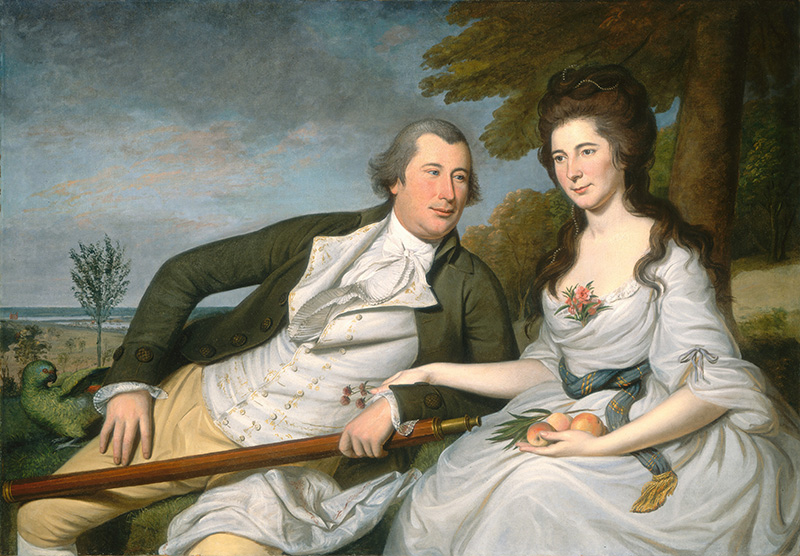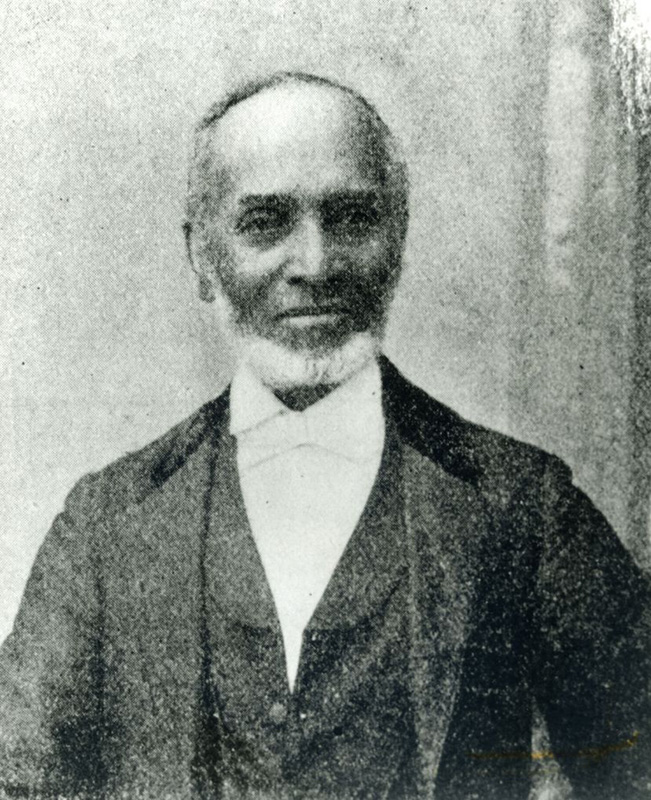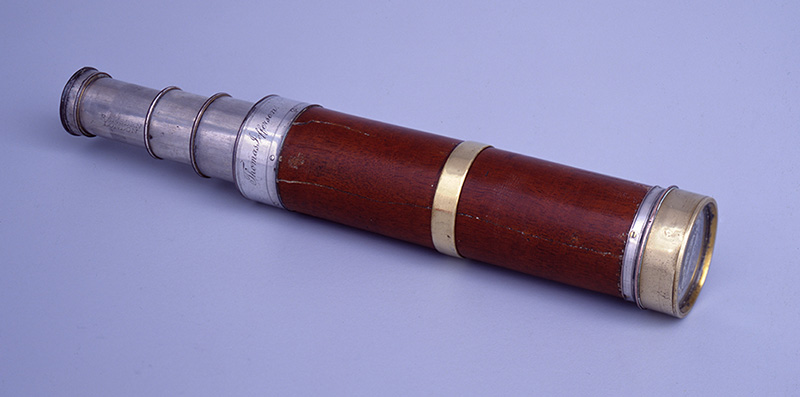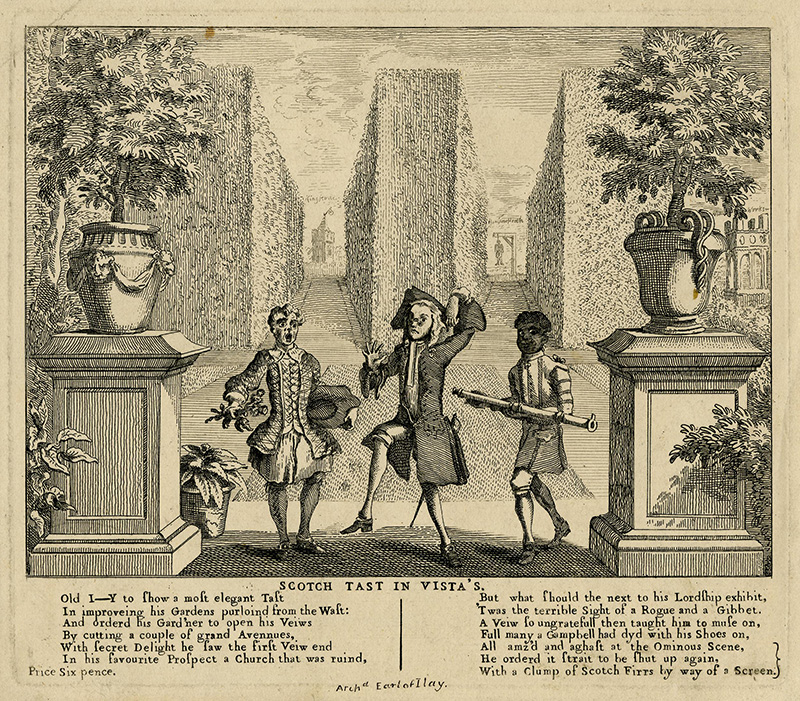Optics and Enslavement in Charles Willson Peale’s Benjamin and Eleanor Laming
by Michael W. Hartman
A 1789 Maryland inventory recorded seven enslaved people—Beck and her children Juliet, Biddy, and Henry; Mary and her daughter Appolonia; and a man called Dick—as the property of Benjamin and Eleanor Laming, the subjects of a double portrait by Charles Willson Peale (figure 1).1 The people enslaved by the Lamings do not appear in Peale’s portrait, but if Benjamin raised the mahogany-barreled spyglass, the optical device would transport his eye down the knoll to Bowley’s Wharf where Beck, Juliet, Biddy, Henry, Mary, Appolonia, and Dick likely unloaded the sugar and rum Laming imported from the Caribbean.2 It is difficult to know how enslaved people might have avoided the surveillance enabled by optical instruments. Archival records privilege people in positions of power, thus removing the perspectives of subjugated peoples from historical documents. Beck, Juliet, Biddy, Henry, Mary, Appolonia, and Dick left no records detailing their experiences.
It took nearly five decades after the Reverend Peter Farley Fossett’s family purchased his freedom in 1850 to finally tell his story of telescopic surveillance to a reporter in 1898 (figure 2). Born at Monticello and enslaved by Thomas Jefferson, Fossett recalled how presidents “Madison and Jefferson spent a great deal of their time… looking through his [Jefferson’s] telescope to see how the work was progressing over at Pan Top.” Pantops was one of Jefferson’s plantations, which he named from the Greek word for “all seeing.”3 Because his mother, Edith Hern Fossett, served as Monticello’s chef, Peter Fossett lived near Jefferson’s house. Due to his proximity, Fossett was one of the few people enslaved by Jefferson to see him participate in telescopic surveillance (figure 3). The people enslaved at Pantops had no means of knowing when their enslaver watched them through his spyglass. Their inability to return Jefferson’s telescopic gaze attests to the inequities of technology-assisted vision. But what if they had been able to look back?
Further south in Jamaica, Jimmy and Bess investigated a watch and spyglass on the piazza of Thomas Thistlewood’s plantation. Thistlewood recorded in his diary how they bent the watch’s hour hand, thereby challenging timed labor schedules designed to increase productivity.4 Perhaps they also intended to damage the spyglass or at least understand its full range of vision so they might evade their enslaver’s telescopic gaze. A related 1741 satirical print, A Scotch Tast in Vista’s, similarly suggests a challenge to the enslaver’s optical power through the portrayal of an Earl and his Black attendant standing outside in a landscaped garden (figure 4). The text below the image informs us that the first avenue, cut through the hedges at left, reveals “with secret delight…[a] favourite Prospect a church that was ruind.” The second cutting at the right unveiled “the terrible Sight of a Rogue and a Gibbet,” a person hanging at a gallows, which the Black attendant invites the Earl to examine in greater detail through the telescope. In holding an optical instrument otherwise reserved for white users, the Black attendant disrupts expectations. His presence suggests a world where vision and access to optical instruments have gone awry, revealing fears that enslaved people would not just evade the telescopic gaze, but could even turn it back upon their enslavers.
Apart from a few well-known portraits by artists like John Hesselius or Justus Englehardt Kühn, enslaved people rarely appeared in 18th-century British colonial or early National art. The bodily absence of Beck, Juliet, Biddy, Henry, Mary, Appolonia, and Dick from Peale’s portrait of the Lamings removed any possibility of visualizing how they challenged or resisted their enslaver’s optically enhanced oversight. By removing the people Laming observed through his spyglass, Peale fashioned Laming as an enslaver unchallenged in his power, creating a portrait that participated in developing ideologies and visual constructions of white superiority. Their absence from the portrait downplayed their very real resistance to their enslavement.
In my dissertation, which has been generously supported by the Decorative Arts Trust, it is not enough for me to simply acknowledge that wealthy white sitters like Benjamin and Eleanor Laming were enslavers. How can we assume that their actions did not extend to who and what this portrait portrays, how it was made, and how it visually operates? The spyglass in Laming’s portrait might have symbolized his interests in shipping or astronomy, as is often said of similar objects in other 18th-century portraits, but we can also see it as the enslaver’s surveillance tool.5 Returning this painting to the landscape where it was made and displayed enriches and expands what we know about this work, while reintroducing Beck, Juliet, Biddy, Henry, Mary, Appolonia, and Dick into a narrative that they, unwillingly, participated in creating. Revisiting artworks like Peale’s double portrait provides an opportunity to disrupt traditional art historical narratives by helping us understand how enslaved people’s presence, actions, and resistance informed the development of 18th-century southern aesthetics.
- Deed of Trust, Benjamin Laming to John Ridgely, 28 December 1789, Baltimore County Court Land Records, 1789-1790, Liber DD, 680-684, Maryland State Archives.
2. For Laming’s imports, see “JUST IMPORTED from Bristol and Nevis,” The Maryland Journal and Baltimore Advertiser, 10 August 1787, p. 2.
3. “Once the Slave of Thomas Jefferson. The Rev. Mr. Fossett, of Cincinnati, Recalls the Days When Men Came from the Ends of the Earth to Consult `the Sage of Monticello’ –Reminiscences of Jefferson, Lafayette, Madison and Monroe, (Special to the Sunday World.) Cincinnati, Jan. 29,” New York World, 30 January 1898, p. 29.
4. Thomas Thistlewood, Thomas Thistlewood Diary, 4 August 1766, p. 196, Box 3, Folder 17, Number 17, Beinecke Library, Yale University. References to telescopes appear throughout Thistlewood’s diary.
5. The spyglass and its placement have also been interpreted as a symbol of Benjamin’s virility. See Margaretta Lovell, “Reading Eighteenth-Century American Family Portraits: Social Images and Self-Images,” Winterthur Portfolio 22, no. 4 (Winter 1987).
Michael W. Hartman is a PhD Candidate in Art History at the University of Delaware and Jonathan Little Cohen Associate Curator of American Art at the Hood Museum of Art, Dartmouth College. Watch the Emerging Scholars Colloquium featuring his lecture on this topic in The Decorative Arts Trust Bulletin.
A print version of this article was published in The Magazine of the Decorative Arts Trust, one of our most popular member benefits. Join today!




